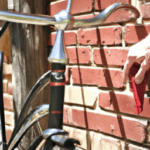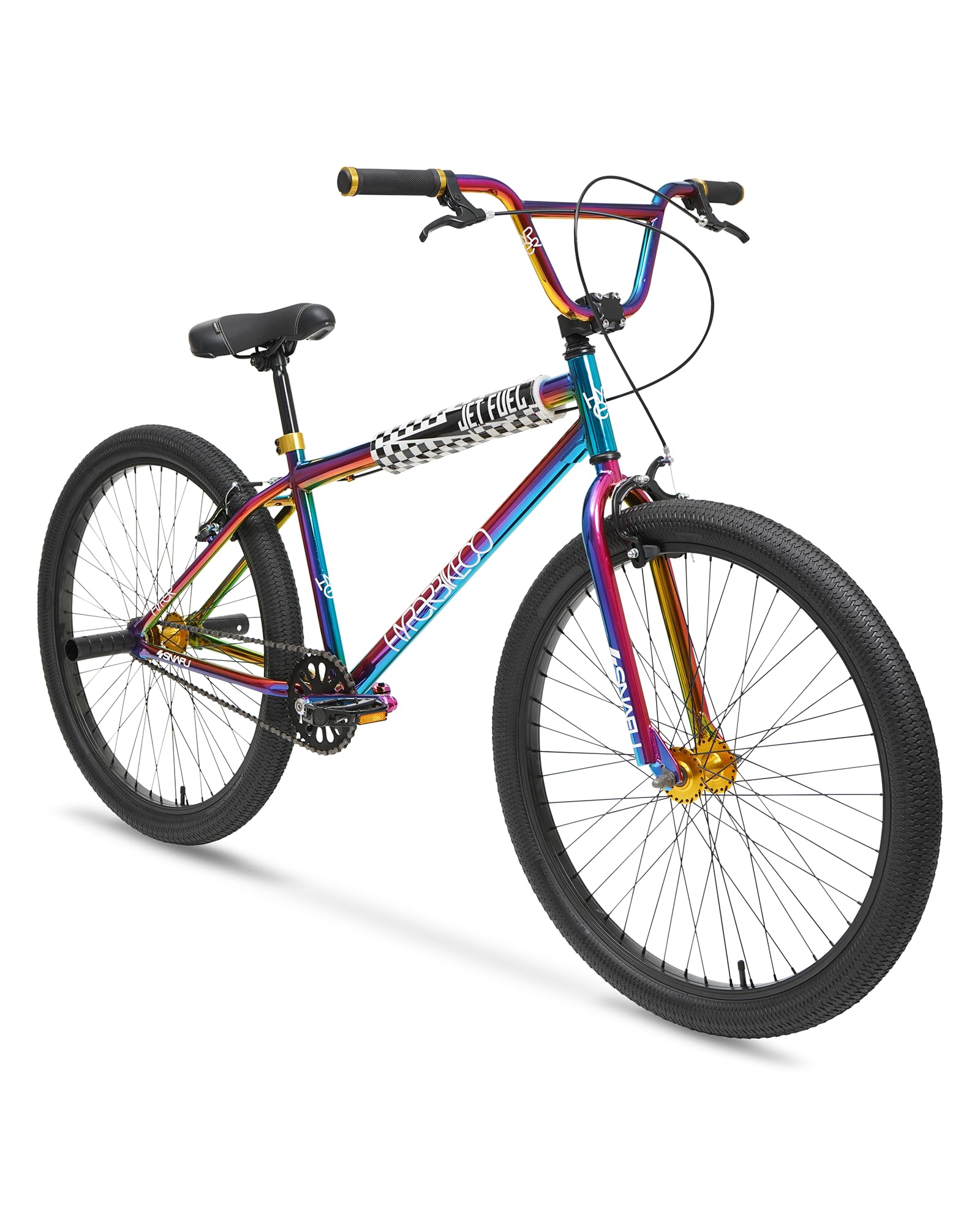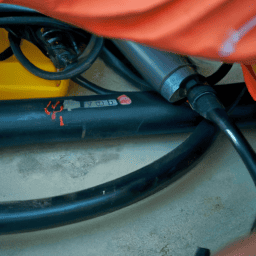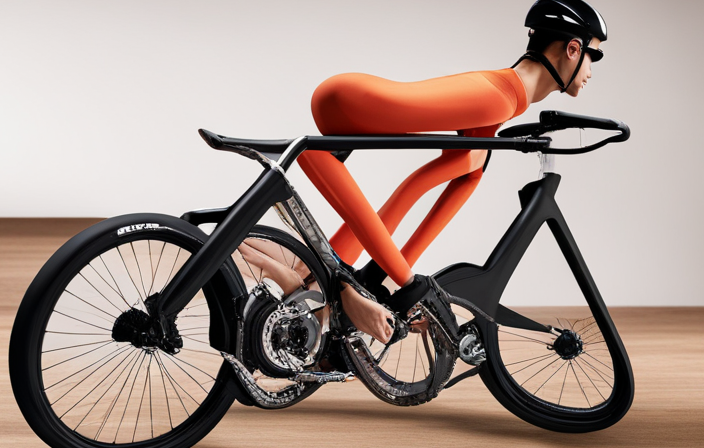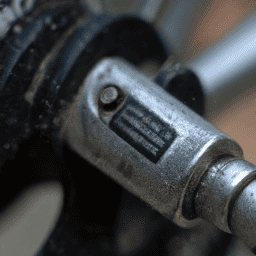Beginners Guides
Where Are KTM Motorcycles Made?
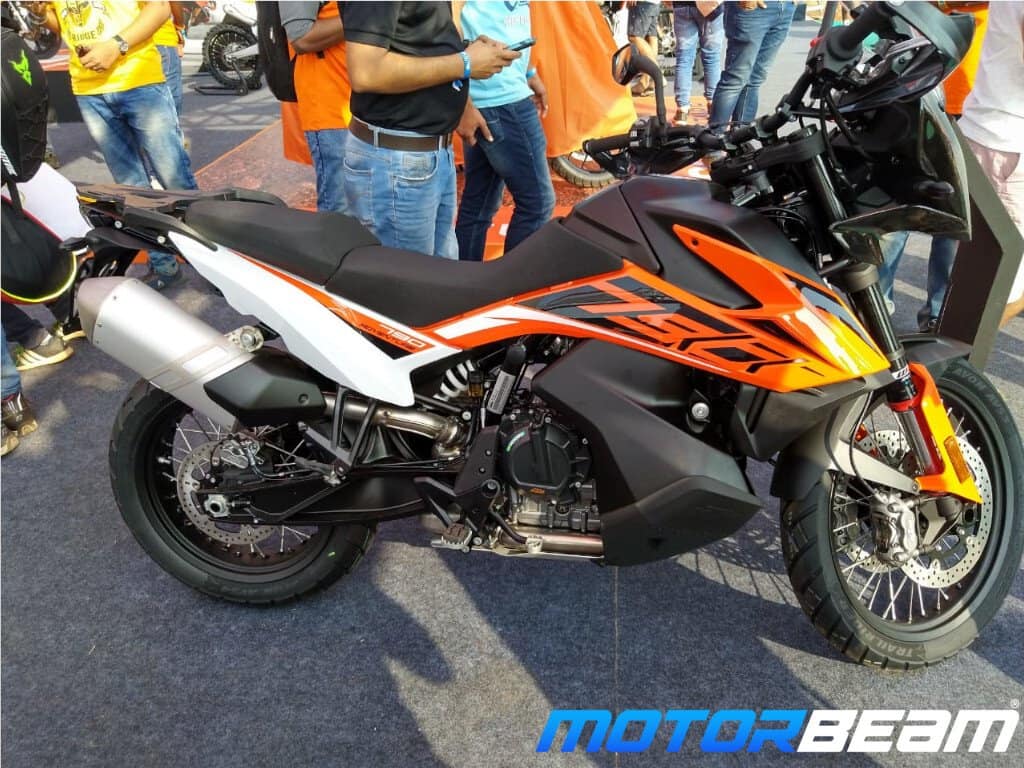
If you’ve been curious about the manufacturing process behind KTM motorcycles, this is the perfect spot for you. Discover the origins of the motorcycle brand in Austria, its manufacturing process in India, and how it reaches 24 different countries. Additionally, get insights into the brand’s achievements both on the road and off-road.
KTM’s origins in Austria
KTM’s origins can be traced back to the early 1950s, when Hans Trunkenpolz set up Kraftfahrzeuge Trunkenpolz Mattighofen to sell DKW motorcycles in Austria. He also began a repair business. The first motorcycle was built in 1951, but the company did not start producing its own engines until nearly two decades later. In 1989, Ernst Kronreif bought a large stake in KTM, which was then split into four separate units.
Since then, KTM has evolved into four distinct branches, each with its own history. In fact, the company has had ups and downs throughout the decades. In the early days, the company was only able to produce 500 motorcycles at a time, but today, it produces over a thousand of them.
Despite its successful history in off-road and road racing, KTM’s history goes much further back. The company’s first motorcycle had an engine rated at 100 cc, which was very powerful for its day. It went on to win the Austrian national championship in the 125-cc category. Later, the company added a scooter called the Mirabell to its range, as well as a sports motorcycle. After this period, KTM introduces the Ponny scooter and the KTM moped.
In 2003, KTM started racing in the 125cc Moto GP road race. In addition, the company began producing bikes with a smaller engine capacity for the street market. This was the perfect time for the company to return to its roots. By the end of the year, the company sold more than 70,000 motorcycles.
After a decade of development, KTM was able to develop mopeds and scooters. The company developed a ladies model for the women, which helped keep skirts and clothing out of the way of moving parts. The company continued to produce mopeds until 1988, but they were discontinued in favour of the newer bikes.
KTM’s history dates back to the early 1950s. It started as a small metal workshop in Mattighofen, Austria. The first motorcycle was an R100, fitted with a 98cc Rotax engine. The company soon became the largest repair workshop in the Upper Austrian region. The company also participated in some of the first motorized racing competitions.
Its production in India
KTM, the Austrian sports bike maker, is looking to expand its presence in the Indian market. The company has plans to launch its Husqvarna brand in India by 2020. Production of the Husqvarna brand in India is expected to begin later this year, and the company plans to use the Bajaj Auto plant in Chakan to make the motorcycles. The plant already has the installed capacity to produce 1 lakh KTM bikes, and the company plans to increase the production capacity there by making up to eight thousand Husqvarna bikes.
KTM’s Indian production will be primarily used to manufacture premium two-wheelers. The new factory is expected to be operational by 2023. It is expected to produce motorcycles up to 500cc. It is anticipated that the new plant will also produce a variety of motorcycles for Bajaj’s premium alliances. For instance, the new facility will likely manufacture KTM 500cc middleweight motorcycles.
In addition to two-stroke motorcycles, KTM is planning to produce a greener, electric version of its Duke naked streetfighter. The new bike will be built in collaboration with Bajaj Auto International Holdings BV, the co-owner of the Duke brand in India. This 48-volt electric bike will be KTM’s first electric bike.
The RC 250 is a lightweight two-seat sports bike that shares the engine of the KTM Duke 250. It has a kerb weight of 147 kg, and is built on a steel trellis frame. It also features ABS and Metzeler tyres.
KTM is among the largest motorcycle manufacturers in Europe, and is the leading off-road motorcycle manufacturer in the world. The company is owned by Pierer Mobility AG and Bajaj Auto Limited International Holdings B.V., and employs more than 25,000 people. Its subsidiaries include KTM Sportmotorcycle GmbH and KTM Werkzeugbau and Kuhler GmbH.
Its distribution in 24 countries
KTM Bike Industries has announced that it has obtained the exclusive distribution rights to sell its bikes in the United States. The company has recently acquired North America Cycles and Cycle Force Group, which will now be the sole distributor for the KTM brand. In addition, the company has also acquired the Husaberg motorcycle company, a company that specializes in off-road motorcycle touring.
KTM is based in Austria, and the company distributes its bikes in 24 countries. KTM’s bikes are used by national teams in competitions around the world. Boettcher rode KTM bikes for seven years until his racing career ended in 1993. Since then, he has been negotiating with the company to distribute their bicycles in North America.
The deal has several benefits for both companies. First of all, it gives Polaris a stronger distribution network throughout Europe. Since both companies are based in Europe, the deal will allow both companies to expand their sales into other regions of the world. Additionally, the combined companies will increase the speed of innovation and development.
KTM has been in the sport bike business for more than four decades. The company has produced several superbikes in the past, including the 1190 RC8 superbike. This superbike is not available in the US, but was still considered street-legal and has a motor similar to that of a MotoGP motorcycle.
KTM’s US line includes 250cc and 350cc four-stroke models in the Motocross segment, as well as 510cc and 500cc enduro motorcycles for competition on longer off-road tracks. The company distributes its products worldwide, including in Europe and Asia.
The company also plans to expand its business in North America. In the coming years, the company expects to increase its sales of MV Agusta motorcycles. It will also launch a dedicated US legal entity to handle MV Agusta operations. The company’s distribution in the US will include select KTM dealers and MV Agusta stores.
Its success on pavement and off-road
The KTM X-Bow is an ultra-lightweight sports car and a mid/rear engine motorcycle designed for street and racetrack use in North America. It is made from carbon fiber and weighs a mere 1,700 pounds. Despite its lightweight construction, the motorcycle is surprisingly powerful, especially for its size.
KTM got its start in road racing back in 2003. It competed in the 125cc and 250cc classes. In 2005, the manufacturer won the Grand Prix constructor’s championship. The following year, KTM won the Moto3 manufacturer’s championship and world championship in the Moto3 class. The brand also fields entries in the MotoGP and Moto2 classes. The company has also raced in the Superbike International German Championships from 2009 to 2011.
The company started with its first two-stroke motorcycle, the R100. The R100 was presented during the fifth Gaisberg Hillclimb competition. It immediately performed far beyond expectations within a year of production. This motorcycle was a favorite among riders, and won the first three places in its first racing activity.
In 1970, KTM had 400 employees. It offered 42 different models. It also began producing radiators for European automakers. This business contributed a major part of the company’s profits in the 1980s. In 1980, the company rebranded itself to KTM Motor-Fahrzeugbau KG. By the following year, it had 700 employees and earned $750 million.
In addition to its off-road motorcycles, KTM also builds street and racetrack bikes. These bikes are built tough enough to handle the roughest terrain. They’re also built for the sporty adventure rider. The KTM 1190 Adventure, for example, is a versatile and capable motorcycle that excels on both.
The 890 Adventure is another excellent bike from KTM. The new model features an 889cc parallel twin engine with 105 horsepower and 73.8 lb-ft of torque. It also features updated ABS, traction control, and improved shifting. This is an impressive motorcycle, and raises the bar in the middleweight adventure segment.
KTM also offers a KTM 500 XC-F. This is the company’s iconic enduro model, and it’s been called the most powerful dual-sport on the market. Its punchy power, responsive rideability, and nimble handling make it a top contender in enduro races.
Beginners Guides
Mastering Bicycle Gear Use on Flat Roads
Uncover the secrets to mastering bicycle gear use on flat roads and revolutionize your cycling performance like never before.

Have you ever wondered if mastering the use of bicycle gears on flat roads could significantly improve your cycling performance? Understanding the intricate gear mechanisms and honing efficient gear changing techniques can truly elevate your riding experience.
But there's more to it than just shifting gears; optimal gear selection and cadence play crucial roles in maximizing your cycling efficiency.
Stay tuned to uncover valuable tips and tricks that will help you become a gear-shifting pro on flat terrains.
Key Takeaways
- Optimize gear ratios with front chainrings and rear cassette for efficient flat road cycling.
- Use precise gear changes to maintain a consistent cadence and power output.
- Avoid common gear mistakes like high gears and cross-chaining for improved performance.
- Experiment with different gear combinations to find the ideal balance of comfort and efficiency.
Gear Mechanism Basics
Exploring the intricacies of the gear mechanism on road bikes reveals the fundamental components that dictate pedaling efficiency and performance on flat terrain. The gear system comprises the front chainrings attached to the pedals and the rear cassette, with its array of cogs offering various resistance levels. The front chainrings play a pivotal role in major speed adjustments, while the rear cassette allows for subtle tweaks to optimize pedaling on flat roads.
When shifting the front chainring, cyclists experience notable gear ratio modifications, significantly impacting the required pedaling effort. On the other hand, adjusting the rear cassette with the appropriate lever enables riders to finely tune resistance levels for maximum efficiency on flat terrain. This manipulation of gears is crucial in maintaining an ideal cadence and power output, ensuring a smooth and effective riding experience.
Understanding the interplay between the chain, cassette, front, rear, lever, and cogs is essential for mastering gear utilization and enhancing cycling performance on flat roads. By grasping these gear mechanism basics, cyclists can unlock the full potential of their road bike and enjoy a liberating and empowering ride.
Efficient Gear Changing Techniques

When optimizing gear changes for flat road cycling, precision in adjusting the rear cassette with the right brake lever is key to maintaining pedaling efficiency and speed control. On flat roads, using the small lever located behind the right brake lever allows for easier and more efficient shifting of the rear gears. By utilizing the right brake lever along with the small lever, cyclists can fine-tune the gearing with their right hand, ensuring smooth gear changes and optimal pedaling efficiency.
Efficient gear changing techniques on flat roads involve utilizing the right lever for precise adjustments to the rear cassette. This method enables cyclists to make minor pedaling speed changes without compromising their momentum. By mastering the art of adjusting the rear gears with the right brake lever, riders can experience a comfortable and efficient cycling experience, where gear changes happen seamlessly, enhancing the overall enjoyment of the ride. Smooth gear changes are essential for maintaining a consistent cadence and achieving a balanced power output on flat terrains.
Optimal Gear Selection Tips
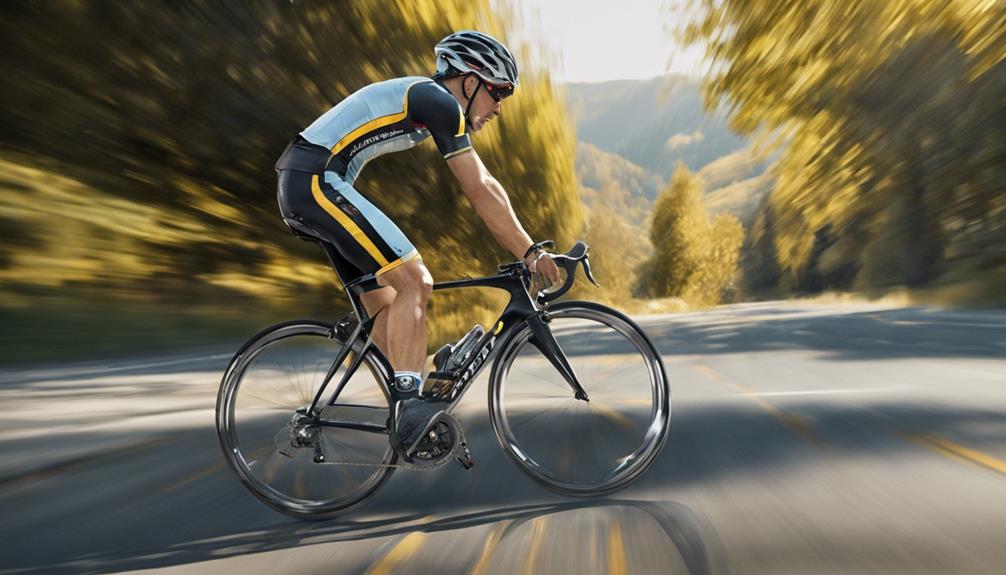
What gear ratios are most suitable for flat road cycling to ensure optimal performance and efficiency? When cycling on flat roads, it's essential to select the right gears to maximize your efficiency and enjoyment. Here are some tips to help you make the best gear selections:
- Choose the Right Crank: Opt for a standard crank if you're a strong rider looking for power on flat terrain, or consider a mid-compact crank for more versatility when encountering varied landscapes.
- Utilize Cassettes with Less Range: Optimal gear selection for flat roads involves using cassettes with a narrower range of gears. This setup allows for seamless transitions between gears, promoting a smoother riding experience.
- Select Appropriate Gear Combinations: Experiment with different gear combinations, including low, middle, and high gears, to find the ones that offer the best balance of comfort and efficiency on flat roads.
Avoiding Common Gear Mistakes
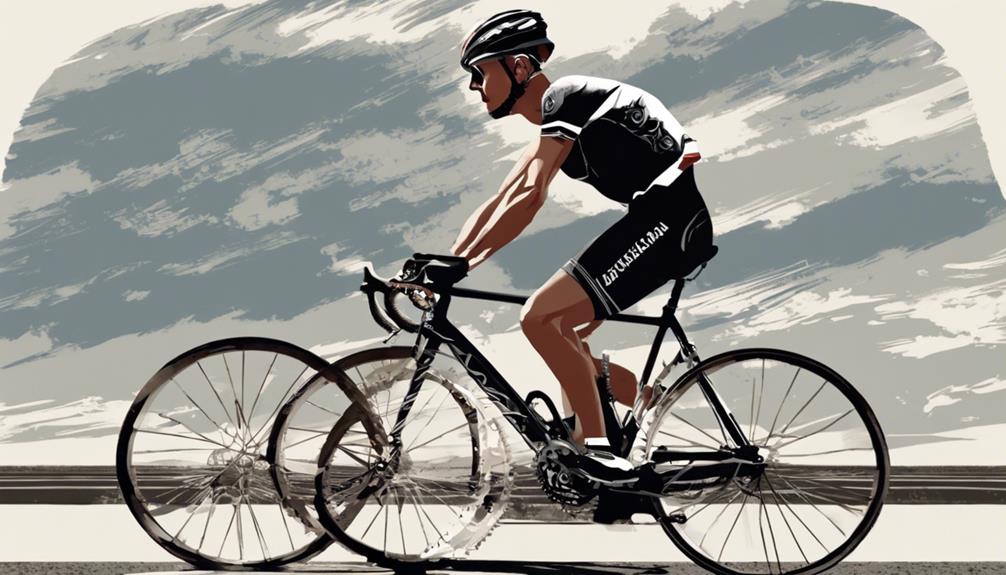
To optimize your performance and prevent strain on flat roads, it's important to avoid common gear mistakes. These include using high gears excessively, maintaining a moderate pace with middle gears, and steering clear of cross-chaining for smoother pedaling.
When cycling on flat terrain, avoiding high gears is crucial to prevent excessive strain on your muscles and joints. Instead, opt for a middle gear to sustain a comfortable pace while conserving energy. Cross-chaining, or using extreme gear combinations, should be avoided to ensure smooth pedaling motion and reduce the risk of gear wear.
Proper gear selection on flat roads is essential for efficiency and reducing fatigue. By utilizing the rear cogs for minor adjustments in gear ratio, you can optimize your cycling experience, enhance comfort, and enjoy a more pleasant ride. Remember, the right gear choice can make a significant difference in your overall performance on flat roads.
Improving Cycling Efficiency on Flats

Improving cycling efficiency on flat terrains requires precise gear selection tailored to the athlete's strength and terrain flexibility, ensuring optimal performance and comfort. When aiming for peak efficiency on flat road conditions, consider the following:
- Optimal Gear Selection: Choose between a standard crank for strong riders or a mid-compact crank for versatility in varied terrains, allowing for better adaptation to flat road conditions.
- Smooth Transitions: Opt for cassettes with narrower gear ratios to facilitate seamless gear changes, promoting smoother transitions and reducing disruptions in cadence on flat surfaces.
- Enhancing Pedaling Efficiency: Experiment with different gear combinations such as low, middle, and high gears to find the optimal balance between effort and speed, maximizing pedaling efficiency for improved cycling performance.
Frequently Asked Questions
What Gear for Flat Road Cycling?
For flat road cycling, we recommend selecting a gear that allows for efficient pedaling without excessive strain. Finding the right balance between resistance and cadence is key to enjoying a smooth and comfortable ride.
What Gear Do You Use to Ride a Flat Bike?
We ride flat roads in a middle gear for smooth pedaling and energy conservation. Choosing the right gear ratio prevents muscle strain and maintains a steady cadence. High gears cover more distance per pedal turn, enhancing performance.
How Do You Use Road Bike Gears Efficiently?
We maximize efficiency by smoothly shifting gears, maintaining cadence on flat roads. Our approach balances speed and power with mid-compact cranks, standard cranks for higher speeds, and narrower range cassettes. Modern drivetrains ensure seamless transitions for a steady ride.
Are Heavier Cyclists Faster on Flat?
We heavier cyclists may have an edge on flat roads thanks to increased momentum and power. The extra weight helps maintain speed and conquer wind resistance. Aerodynamics and power-to-weight ratio also matter, especially in time trials.
Conclusion
In conclusion, mastering bicycle gear use on flat roads is like finding the perfect rhythm in a symphony. Each gear change is a note played with precision, blending seamlessly to create a harmonious cycling experience.
By understanding the mechanics, practicing efficient techniques, and selecting optimal gears, cyclists can pedal with ease and grace. Just as a conductor directs an orchestra, mastering gear use allows us to control our ride with finesse and confidence.
Olivia’s writing is not only informative but also inspiring. She has a knack for telling stories that capture the essence of cycling and the joy it brings to people’s lives. Her writing has been praised by readers and industry experts alike for its clarity, depth, and authenticity.
In addition to her writing, Olivia is also an avid cyclist. She enjoys exploring new trails and routes and has participated in several cycling events and races. Her first-hand experience with cycling gives her a unique perspective on the sport, reflected in her writing.
Overall, Olivia is a talented writer passionate about cycling and dedicated to producing high-quality content for FlatironBike. Her contributions to the magazine have helped make it a go-to source for cycling enthusiasts worldwide.
Beginners Guides
7 Ways a Bicycle Is Useful to Us
Pedal into a world of possibilities with the incredible benefits a bicycle offers – from personal health to environmental impact.

Riding a bicycle is like unlocking a treasure chest of benefits waiting to be discovered. From boosting our physical health to reducing our carbon footprint, a bicycle is a versatile tool that offers more than meets the eye.
Let's explore the seven ways a bicycle can positively impact our lives and society as a whole.
Key Takeaways
- Improves physical health by enhancing fitness levels and strengthening muscles.
- Reduces environmental impact by cutting pollution and promoting sustainability.
- Saves money through cost-effective commuting and minimal maintenance costs.
- Enhances mental well-being by reducing stress, boosting brain function, and fostering social connections.
Health Benefits of Cycling
Cycling offers a myriad of health benefits, reducing the risk of various health conditions and improving overall fitness levels. Engaging in regular cycling serves as an excellent form of exercise that enhances cardiovascular fitness and muscle strength. This aerobic exercise not only aids in weight loss but also lowers the risk of stroke, heart attack, cancer, depression, diabetes, obesity, and arthritis. Just dedicating 2-4 hours per week to cycling can lead to significant health improvements, making it a time-efficient way to stay fit.
Additionally, the mental health benefits of cycling are noteworthy, as it provides a means to replace sedentary time with physical activity, promoting overall well-being. Even individuals with physical limitations can benefit from hand cycling, which offers cardiovascular and aerobic advantages for those with amputations, spinal injuries, or stroke recovery. Cycling truly embodies the essence of holistic health and vitality.
Environmental Friendliness
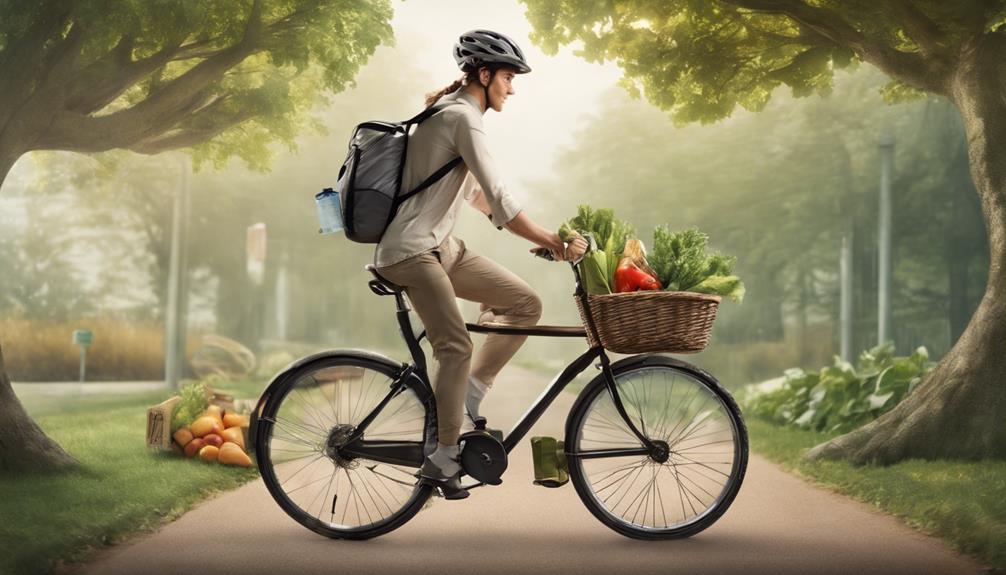
Bicycles, as an eco-friendly mode of transportation, play a crucial role in reducing pollution and promoting environmental sustainability. Riding a bike isn't only environmentally friendly but also offers numerous health benefits. Compared to vehicle passengers, cyclists inhale less pollution, contributing to better overall health. Commuting by bike significantly reduces the transportation carbon footprint by 67%, making it a sustainable choice for those concerned about environmental conservation.
In urban areas, where congestion and emissions are pressing issues, bikes provide a cleaner and healthier transportation option. By choosing to cycle instead of drive, individuals can actively help to reduce emissions and alleviate traffic congestion. Cycling not only benefits the individual rider but also contributes to a cleaner environment for all. Embracing bicycles as a means of transport is a step towards creating a more sustainable and eco-conscious society.
Cost-Effective Transportation Solution

Cycling offers an economic travel option for individuals seeking a budget-friendly commuting choice. By opting for a bicycle, we can enjoy an affordable way to travel that saves us money on fuel, insurance, and parking fees.
The minimal maintenance costs of bicycles compared to cars make them a cost-effective transportation solution for daily commuting needs.
Economic Travel Option
Embracing two-wheeled travel offers a budget-friendly and efficient way to navigate urban landscapes, saving on various transportation expenses. Cycling as an economic travel option not only helps in avoiding traffic congestion and parking expenses but also reduces the overall cost of commuting compared to owning a car. Bicycling serves as a cost-effective mode of transportation, cutting down expenses on fuel, registration, insurance, and maintenance. Furthermore, it promotes physical fitness, eliminating the need for costly gym memberships. By choosing bicycles for transportation, individuals can enjoy the built-in exercise benefits while minimizing travel costs.
| Benefits | Description |
|---|---|
| Cost-Effective | Saves money on fuel, registration, insurance, and maintenance. |
| Traffic Congestion | Helps in avoiding congested roads, leading to faster and more reliable travel. |
| Parking Expenses | Eliminates the need for expensive parking fees in urban areas. |
| Physical Fitness | Promotes health and wellness through regular physical activity. |
| Built-in Exercise Benefits | Provides exercise benefits while commuting, reducing the need for a separate gym membership. |
Budget-Friendly Commuting Choice
Navigating urban landscapes on two wheels presents a budget-friendly and efficient means of transportation, offering significant savings on various commuting expenses. Commuting by bike is a cost-effective option that helps individuals save money on fuel, maintenance, insurance, and registration fees.
Choosing a bicycle for commuting is an economical mode of transport, reducing overall transportation expenses and avoiding the high costs associated with car ownership. Cycling as transportation provides significant savings over time, making it a wise financial decision for those looking to cut down on commuting costs.
Affordable Way to Travel
When considering cost-effective transportation solutions, utilizing bicycles emerges as a practical and economical choice for travel. Cycling is an affordable way to travel, significantly reducing transportation costs compared to owning and maintaining a car. Here are some key points highlighting why cycling is a budget-friendly and practical option for travel:
- Bicycles are a cost-effective mode of transportation, saving money on fuel, registration, insurance, and maintenance.
- Using a bicycle for transportation helps avoid expenses associated with car ownership, making it a budget-friendly option.
- Bicycles provide an economical travel solution, minimizing the financial burden of fuel prices and maintenance fees.
- Choosing a bicycle for transportation is a practical and affordable option that contributes to overall cost savings.
Physical Fitness Improvement
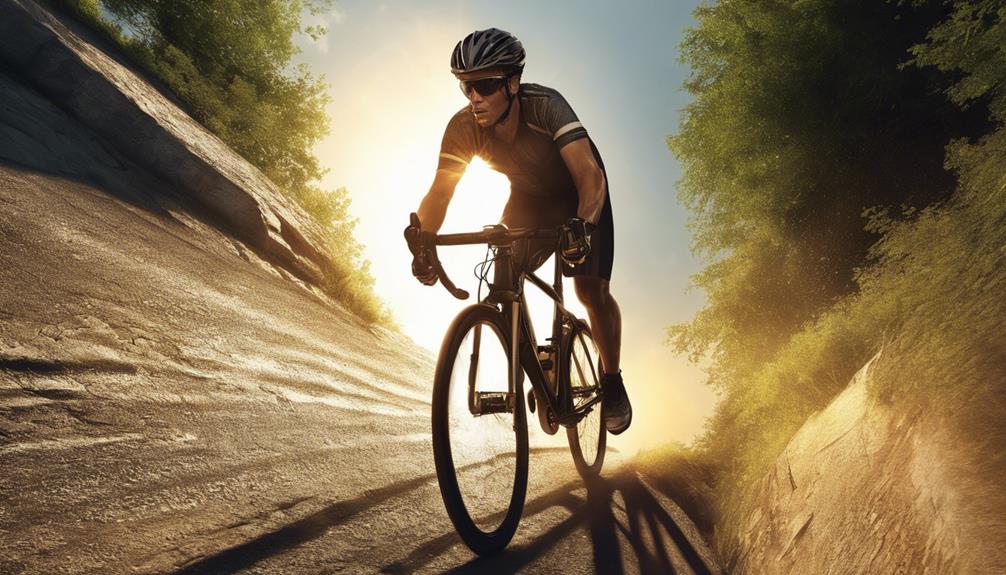
Cycling offers a substantial boost to our physical fitness levels by targeting key muscle groups and enhancing cardiovascular health. It's a low-impact exercise that strengthens the legs and improves balance, coordination, and posture.
Regular cycling sessions can help improve stamina, endurance, and overall cardiovascular function, making it a fantastic workout choice for individuals of all fitness levels.
Health Benefits
Improving physical fitness through cycling offers a range of benefits, including strengthening leg muscles, enhancing balance, posture, and coordination, and targeting key muscle groups such as quads, glutes, hamstrings, and calves.
Cycling is a low-impact exercise option that's gentle on the body and enhances cardiovascular function and overall fitness levels. It provides a time-efficient way to get fit and replace sedentary time with healthy exercise, benefiting individuals of all ages.
Regular cycling strengthens the cardiovascular system, enabling more exercise with less effort, and helps individuals achieve physical activity guidelines effectively. Adults cycling use 10 times more oxygen than sitting, promoting respiratory health by making the lungs work harder and delivering more oxygen where it's needed.
Cardiovascular Workout
Enhancing cardiovascular fitness through regular cycling contributes significantly to overall physical well-being and health. Cycling provides an effective cardiovascular workout, strengthening the heart, improving blood circulation, and lowering blood pressure.
By increasing heart rate, cycling helps improve cardiovascular fitness, reduce the risk of heart disease and stroke, and enhance endurance. This low-impact exercise is gentle on the joints while still offering a challenging workout.
Consistent cycling sessions lead to improved heart health, increased stamina, and enhanced physical fitness levels. Incorporating cycling into a routine not only benefits the heart but also contributes to overall well-being by boosting fitness and lowering the risks associated with a sedentary lifestyle.
Stress Reduction and Mental Wellbeing

Stress levels can be effectively reduced and mental well-being promoted through the scientifically proven benefits of cycling. Cycling isn't just a physical activity; it also has significant positive effects on mental health. Here are some key ways cycling contributes to stress reduction and mental well-being:
- Cycling releases endorphins, known as 'feel-good' hormones, which help reduce stress, anxiety, and depression.
- Regular cycling boosts brain function, enhances cognitive abilities, and improves overall mental health.
- Engaging in cycling stimulates blood flow to the brain, aiding in relaxation, focus, and concentration.
- Studies show that cycling is as effective as medication in reducing stress and promoting a positive mindset.
Community Connection and Social Interaction

Cycling not only promotes physical health but also nurtures a sense of community and encourages social interactions among individuals with shared interests. Riding a bicycle creates opportunities for community connection and social engagement through various avenues such as cycling clubs, group rides, and cycling events. Cyclists often come together to share their passion for biking, meet new people, make friends, and form lasting bonds.
| Community Connection | Social Interaction |
|---|---|
| Cycling clubs provide a platform for cyclists to engage with like-minded individuals. | Group rides offer a chance to connect with others while enjoying the thrill of cycling. |
| Community bike events, like charity rides or cycling festivals, foster an inclusive environment for cyclists. | Participating in cycling events allows cyclists to meet new people and form friendships based on their shared love for biking. |
In these settings, individuals find a supportive community that not only values their shared interest in cycling but also encourages social connections and interactions.
Sustainable and Green Lifestyle Choice

Choosing to ride a bicycle aligns with sustainable living practices and reduces our reliance on non-renewable resources. Bicycles are a sustainable transportation choice, producing zero emissions and reducing the carbon footprint. Opting for cycling helps create a greener environment by decreasing air pollution and harmful emissions. Cycling promotes a green lifestyle by minimizing the use of fossil fuels and contributing to cleaner air.
It's an eco-friendly mode of transport that supports the preservation of natural resources and aligns with sustainable living practices. By choosing bicycles over cars, we actively participate in reducing our carbon footprint and promoting green transportation. Embracing cycling as a sustainable and green lifestyle choice not only benefits our health but also plays a significant role in preserving the environment for future generations.
Let's pedal towards a more sustainable future together.
Frequently Asked Questions
What Can Bicycles Be Used For?
Bicycles can be used for commuting to work, school, or other destinations, reducing reliance on cars and public transportation. They are ideal for recreational purposes such as cycling tours, exploring nature trails, or participating in cycling events.
How Does the Bicycle Help Society?
Cycling weaves our urban tapestry with threads of health, community, and sustainability. Bicycles untangle traffic knots, paint green strokes on carbon clouds, and pedal us into a brighter, closer-knit future.
How Was the Bicycle Important?
The bicycle was crucial throughout history, revolutionizing transportation, empowering women, boosting economies, and promoting public health. Its impact continues to be felt worldwide, providing reliable transport and fostering physical activity, making it a truly enduring invention.
How Do Bikes Help the Environment?
Cycling, like a green breeze, helps the environment by reducing carbon emissions and air pollution. Bicycles are a sustainable transportation choice, cutting down our carbon footprint significantly compared to driving, contributing to cleaner air quality.
Conclusion
In conclusion, cycling offers a multitude of benefits for our health, the environment, and our wallets.
Did you know that cycling just 20 miles a week can reduce the risk of heart disease by 50%?
With its ability to improve physical fitness, mental well-being, and community connections, biking is truly a valuable and enjoyable way to stay healthy and happy.
So grab your helmet and hit the road for a sustainable and rewarding lifestyle choice!
Olivia’s writing is not only informative but also inspiring. She has a knack for telling stories that capture the essence of cycling and the joy it brings to people’s lives. Her writing has been praised by readers and industry experts alike for its clarity, depth, and authenticity.
In addition to her writing, Olivia is also an avid cyclist. She enjoys exploring new trails and routes and has participated in several cycling events and races. Her first-hand experience with cycling gives her a unique perspective on the sport, reflected in her writing.
Overall, Olivia is a talented writer passionate about cycling and dedicated to producing high-quality content for FlatironBike. Her contributions to the magazine have helped make it a go-to source for cycling enthusiasts worldwide.
Beginners Guides
What Are the Basics of How a Bicycle Freewheel Works?
Leveraging intricate mechanisms, bicycle freewheels allow wheels to spin freely—discover the fascinating basics and functions behind this essential component.

When we hop on our bicycles, we often take for granted the intricate workings of the freewheel in the rear hub. Did you know that the freewheel plays a vital role in allowing the wheel to rotate independently of the pedals?
Understanding the mechanisms behind how a bicycle freewheel operates can provide valuable insight into the smooth functioning of this essential component. Let's explore the inner workings of different types of freewheels and uncover the basics of their functionality to gain a deeper appreciation for this often overlooked yet crucial part of our bikes.
Key Takeaways
- Pawls and ratchets enable torque transmission and wheel movement.
- Ratchet and pawl mechanism ensures smooth power transfer and rider flexibility.
- Star ratchet freewheels offer robust construction and reliability on challenging terrains.
- Roller freewheels use ball bearing design for durability and smooth operation.
Components of a Bicycle Freewheel
In a bicycle freewheel, the components responsible for transmitting torque and facilitating forward pedaling are the pawls and ratchets. The ratchet and pawl system in the freewheel is integral to its function.
The pawls, small spring-loaded components, engage with the ratchet's teeth to allow the wheel to turn when the pedals are in use. This interaction forms the basis of the drive system, enabling the transfer of power from the rider's pedaling to the wheel.
The star ratchet design within the freewheel ensures that the pedals remain stationary when the wheel is spinning freely, preventing any unwanted backward rotation. When coasting or not pedaling, the pawls disengage from the ratchet, allowing the wheel to rotate independently without resistance.
This intricate mechanism of pawls and ratchets in the freewheel guarantees a smooth and efficient forward motion while offering the rider the freedom to pedal without constraint.
Ratchet and Pawl Mechanism Explained

Exploring the inner workings of a bicycle freewheel reveals the intricate and efficient system known as the ratchet and pawl mechanism. This mechanism plays a crucial role in enabling torque transmission and facilitating the forward movement of the bicycle.
Here's a breakdown of its key components:
- Ratchet and Pawl Interaction: The pawls engage with the teeth on the ratchet, allowing the wheel to move forward when the pedals are in motion.
- Disengagement for Free Movement: When the pedals are reversed, the pawls disengage from the ratchet, enabling free movement without propulsion.
- Spring Mechanism for Torque Transmission: A spring mechanism within the system ensures that the pawls engage effectively with the ratchet to transmit torque seamlessly.
- Audible Click Feature: The characteristic click sound heard when reversing pedals signifies the engagement and disengagement of the pawls with the ratchet.
This precise and reliable design ensures that the bicycle freewheel operates smoothly, providing efficient power transfer while maintaining the flexibility and freedom desired by cyclists.
Understanding Star Ratchet Freewheels

Amid the realm of bicycle freewheel mechanisms, star ratchet freewheels stand out for their robust construction and enhanced durability. Consisting of two toothed discs with slanted teeth pressed together by a spring during pedaling, these freewheels excel in demanding riding conditions like freeride and downhill.
When idling, the toothed discs in star ratchet freewheels move against each other, creating a characteristic noise that provides riders with distinct auditory feedback. This noise is a result of the discs moving against each other, signifying the reliability and durability of this freewheel mechanism.
The robust nature of star ratchet freewheels makes them a preferred choice for riders tackling challenging terrains, especially when going downhill. The enhanced durability of these freewheels ensures that riders can trust their rear wheel's performance even in the most demanding situations, offering a sense of freedom and confidence while riding.
Inner Workings of Roller Freewheels

Utilizing pinch rollers that are pressed against the hub during pedaling, roller freewheels propel the bicycle forward with efficiency and minimal noise. The inner workings of roller freewheels involve a sophisticated design that ensures seamless functionality.
Here's a closer look at how roller freewheels operate:
- Pinch Roller Mechanism: Pinch rollers are key components that make direct contact with the rear sprocket, transferring power efficiently during pedaling.
- Guide Tracks: These rollers move freely within guide tracks when coasting, resulting in a noiseless riding experience.
- Ball Bearing Design: Similar to ball bearings, roller freewheels are designed for smooth and quiet operation, enhancing the overall riding experience.
- Durability and Reliability: Roller freewheels are renowned for their durability and long service life, making them a dependable choice for riders seeking a silent ride.
The meticulous engineering behind roller freewheels ensures smooth engagement under load and quiet operation while coasting, offering riders the freedom to enjoy a peaceful cycling experience.
Functionality of Sprag Clutch Freewheels
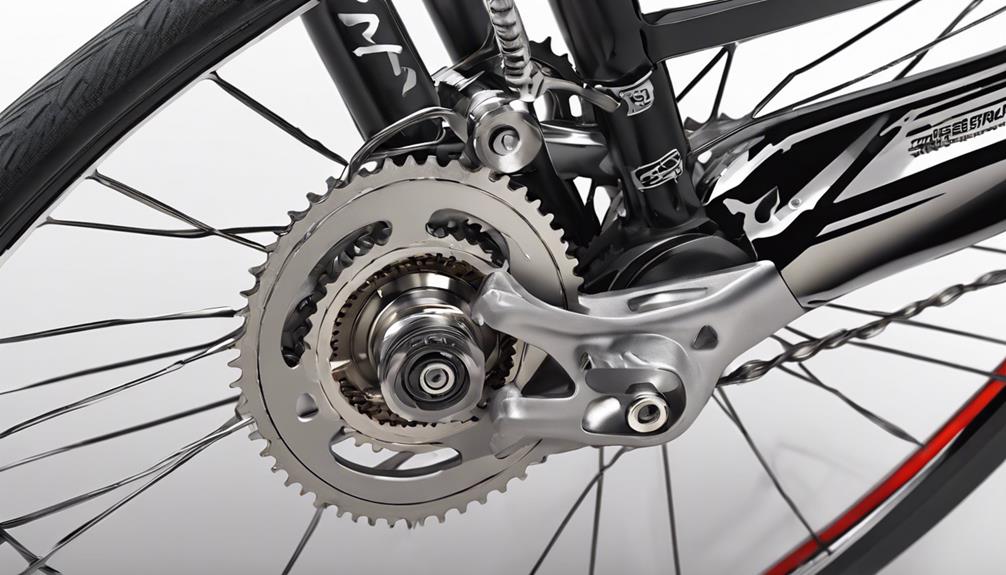
Sprag clutch freewheels employ sprags to facilitate torque transmission within bicycles, ensuring efficient power transfer. When the cyclist stops pedaling, the sprags disengage, allowing the wheel to spin freely without moving the pedals. The design of sprag clutch freewheels enables smooth engagement and disengagement, leading to efficient power transfer when pedaling resumes. The instant engagement of the sprags ensures quick and responsive power delivery, enhancing the overall riding experience.
Due to their simple yet effective design, sprag clutch freewheels require minimal maintenance. Cyclists can enjoy reliable performance in various riding conditions without the need for frequent adjustments or repairs. The durability and functionality of sprag clutch mechanisms make them a popular choice among cyclists seeking consistent and hassle-free operation. Whether navigating city streets or tackling rugged terrains, sprag clutch freewheels provide the necessary torque transmission for a smooth and enjoyable ride.
Frequently Asked Questions
How Does a Bicycle Freewheel Work?
We know how a bicycle freewheel works. It allows pedals to rotate independently from the rear wheel, ensuring smooth coasting. The mechanism engages during forward pedaling and disengages when coasting or backpedaling, playing a vital role in efficient cycling.
What Is the Principle of Freewheel?
Freewheeling is akin to a river flowing, allowing us to move forward effortlessly. The principle of a freewheel is to enable coasting by disconnecting pedals from the wheel, granting us the freedom to control our speed effortlessly.
What Is the Free Wheeling Technique?
Freewheeling technique on a bicycle involves coasting without pedaling, allowing riders to conserve energy and maintain momentum. It's crucial for controlling speed and balance during descents, enhancing the overall riding experience.
What Is the Difference Between a Freewheel and a Freehub?
We differentiate between a freewheel and a freehub by their attachment methods to the hub and compatibility with sprocket configurations. Freewheels thread onto hubs with a lockring, while freehubs use a splined interface for cassettes, offering more versatility.
Conclusion
In conclusion, the bicycle freewheel is a marvel of engineering, allowing for seamless transmission of power while enabling the wheel to rotate independently of the pedals.
Its intricate mechanisms, such as the ratchet and pawl, star ratchet, roller, and sprag clutch, work in harmony to provide cyclists with a smooth and efficient riding experience.
The freewheel is like a symphony of precision, orchestrating the dance between pedal power and wheel rotation with unparalleled grace and finesse.
Olivia’s writing is not only informative but also inspiring. She has a knack for telling stories that capture the essence of cycling and the joy it brings to people’s lives. Her writing has been praised by readers and industry experts alike for its clarity, depth, and authenticity.
In addition to her writing, Olivia is also an avid cyclist. She enjoys exploring new trails and routes and has participated in several cycling events and races. Her first-hand experience with cycling gives her a unique perspective on the sport, reflected in her writing.
Overall, Olivia is a talented writer passionate about cycling and dedicated to producing high-quality content for FlatironBike. Her contributions to the magazine have helped make it a go-to source for cycling enthusiasts worldwide.
-

 Electric Bike3 months ago
Electric Bike3 months agoHow To Turn Your Bike Into An Electric Generator
-

 Bike2 months ago
Bike2 months agoAdvantages and Disadvantages of a Carbon Fiber Bike Frame
-

 Beginners Guides2 months ago
Beginners Guides2 months agoA Guide to Right Hybrid Bike Posture: How to Sit on the Bike for Optimal Performance
-
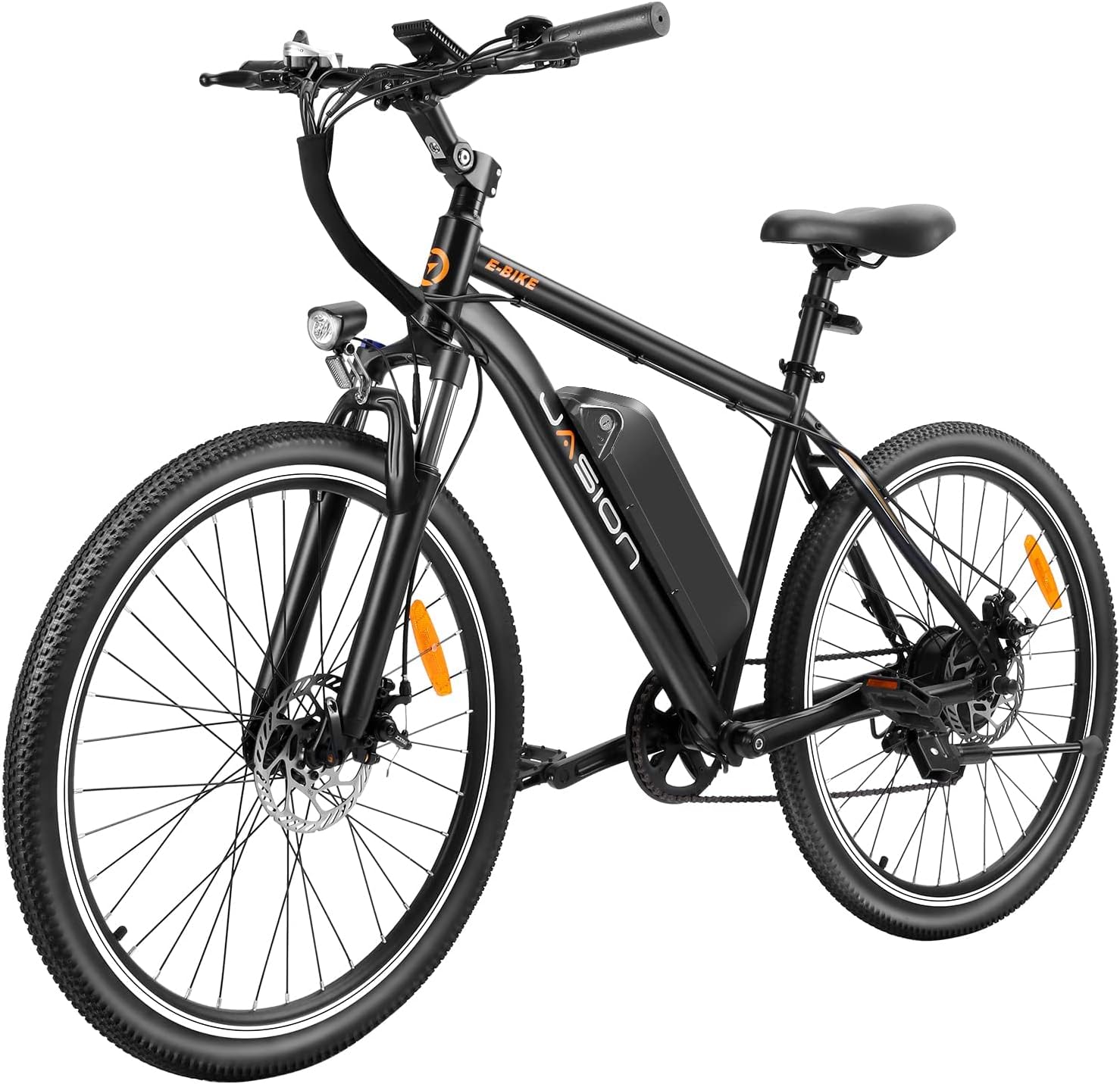
 Vetted3 months ago
Vetted3 months agoJasion EB5 Electric Bike Review: Commute Mountain Bike for Adults
-
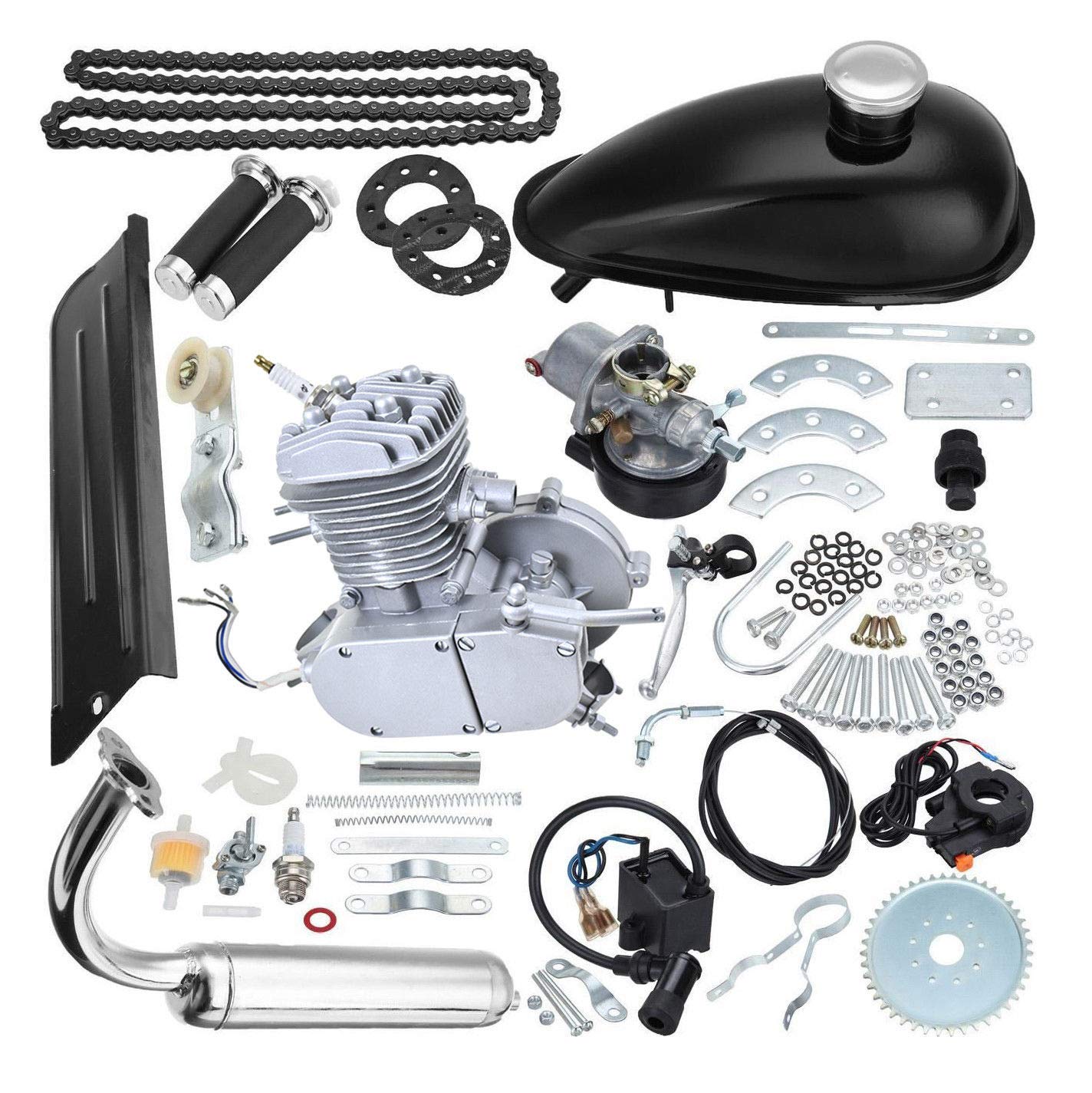
 Vetted3 months ago
Vetted3 months agoReview: 80CC Motorized Bicycle Gas Engine Kit with Performance Carburetor
-

 Vetted3 months ago
Vetted3 months agoFREESKY Electric Bike Review: 1000W Motor, 48V Battery, Full Suspension
-

 Electric Bike3 months ago
Electric Bike3 months agoHow To Program Electric Bike Controller For More Speed
-
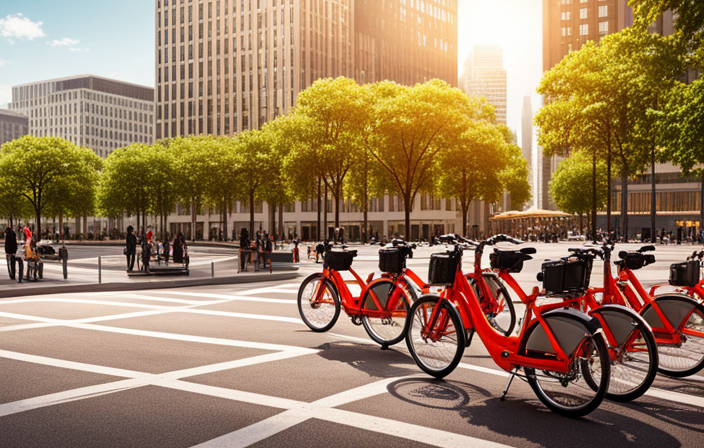
 Electric Bike3 months ago
Electric Bike3 months agoWhere To Get Free Electric Hybrid Bike








